 WARNING WARNINGAlways unplug this product from the electrical outlet before removing, cleaning, servicing or making any adjustment to the product. Water Sanitation
The spa owner must regularly check and keep the spa water sanitized with scheduled maintenance (daily, if necessary). Adding sanitizer and other chemical will control bacteria and viruses present in the spa water. The maintenance of a proper water balance through appropriate use of sanitizers is the single most important factor in maximizing the life and appearance of the spa tub as well as ensuring clean, healthy and safe water. Proper technique is important for water testing and treating the spa water. See your pool/spa professional for chemical, sanitizer, test kits and testing procedures questions. CAUTION: ALWAYS FOLLOW THE CHEMICAL MANUFACTURER'S DIRECTIONS, AND THE HEALTH AND HAZARD WARNINGS. Do not add chemicals if the spa is occupied. This can cause skin or eye irritation. Concentrated chlorine solutions can damage the spa tub. In no event is Intex Recreation Corp., Intex Development Co. Ltd., their related companies, authorized agents and service centers, retailers or employees liable to the buyer or any other party for costs associated with the loss of spa water, chemicals or water damage. Maintenance of Spa Water and Cartridge
Protect all the spa occupants from possible water-related illnesses by keeping the spa water clean and sanitized.
Always practice good hygiene. To ensure proper spa water quality follow these procedures:
1. Inspect and clean the filter cartridge every day, and change the filter cartridge every 3 days.
a. Unscrew the cartridge housing assembly from the spa tub wall and remove the cartridge (see drawing 13).
b. Use a garden hose to rinse off the cartridge. If the cartridge remains soiled and discolored it should be replaced. Keep spare cartridges on hand.
c. Reinstall the clean cartridge back into the cartridge housing and replace the cartridge housing assembly back onto the spa tub wall.
2. Change the spa water every 2 weeks. See "Spa Tub Drainage" and "Spa Tub Cleaning" sections for details.
3. Use spa chemicals to maintain proper water chemistry. Spa damage resulting from misuse of chemicals and mismanagement of spa water is not covered by the warranty.
4. All occupants must shower before entering the spa. 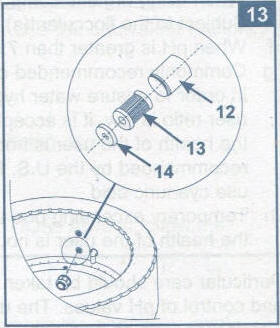
Water Chemistry Balance
Maintain the spa water pH level between 6.8 and 7.6, total alkalinity level between 60 and 120 ppm and free chlorine level between 2 to 4 ppm. Use the included test strips to test the spa water chemistry before each use of the spa and continue to test the water no less than once a week.
The Test Strips can test the "Free Chlorine", "pH", "Total Alkalinity" and "Calcium Hardness" levels at the same time:
1. Dip the entire strip into the water and remove immediately.
2. Hold the strip level for 15 seconds. Do not shake excess water from the strip.
3. Compare the strip pad to the color chart on the packaging label. If necessary, adjust the chemical level in the pool water. NOTE: Check the expiry date of the test kit as the test results may be inaccurate if the kit is used after that date.
Low pH will damage the spa tub and pump. Damage resulting from chemical imbalance is not covered by the warranty. Use the included chemical floater dispenser to administer chlorine [chemical tablet size: less than 1" (2.5 cm) diameter] into the spa water. Add 1 tablet into the dispenser. Always follow the chemical manufacturer's directions. Remove the chemical floater dispenser when the spa is in use.
Never let chlorine come in contact with the spa tub if it is not completely dissolved.
Flush all pipes with treated water by activating the bubble function for an hour a day. IMPORTANT: Press the  button on the spa control panel to turn on the bubble air blower and help dissolve the chemicals into the water. button on the spa control panel to turn on the bubble air blower and help dissolve the chemicals into the water.
Never mix chemicals together. Add the chemicals to the spa water separately. Thoroughly dissolve each chemical before adding another one to the water. SPA WATER CHEMISTRY AND BALANCE | Parameter | Value a |
|---|
| Water clarity | clear view of the bottom | | Total Alkalinity (TA) in mg/l | 60 to 120 | | Calcium Hardness (CaCQ3) in mg/1 | 150 to 250 | | Colour of the water | no colour should be observed b,c | | Turbidity in FNU/NTU | max. 1.5
(preferably less than 0.5) | | Nitrate concentration above that of fill water in mg/l | max. difference of 20 compared to the fill water concentration | | Total organic carbon (TOC) in mg/l d | max. 4.0 | | Redox potential against Ag/AgCI 3.5 M KCI in mV | min. 650 | | pH value e,f | 6.8 to 7.6 | | Free active chlorine (without cyanuric acid) in mg/l | 0.3 to 1.5 g | | Bromine in mg/l | 2.0 to 4.0 h | | When using alternative/additional disinfectants other appropriate parameters may be considered. |
a Consult national regulations and guidelines for any deviations.
b Natural water sources may introduce water colouration.
c Intentional water colouration is excluded.
d When using organic compounds this value may be higher.
e Subject to the flocculant(s) used (if any).
f When pH is greater than 7.5 the free active chlorine is less than 50%.
g Commonly recommended concentration of free chlorine in aquatic settings is 0.3 to 1.5 mg/l. However, in order to ensure water hygiene in the spa setting where the water is heated and the water volume to user ratio is low, it is acceptable to temporarily exceed this concentration with manual dosage, provided the health of the user is not compromised. Therefore, a range of 2.0 to 4.0 mg/l is acceptable as also recommended by the U.S. Environmental Protection Agency and the Center for Disease Control. Do not use cyanuric acid.
h Temporary exceeding due to manual dosage and low water volume to user ratio is acceptable, provided the health of the user is not compromised. |
Particular care should be taken with chemical treatment of the water with special attention to disinfectant limits and control of pH values. The use of ozone or UV, where applicable, shall always be accompanied by residual disinfection with an oxidising biocide (e.g. Chlorine or Bromine or other biocide products, compatible with manufacturer's recommendations).
Improper use of chemicals may result in degradation, damage and other imperfections of the spa surface and other spa components (typically discolouration of materials, corrosion of metal parts). Free chlorine: is the chlorine residual present in the spa water.
Result if too low - Inadequate level of disinfection.
Result if too high - cause odor problem, skin & eye irritation, corroded metals and other materials. pH: a value that indicates how acidic or basic the spa water is.
Result if too low - Corroded metals, eye & skin irritation, and destruction of total alkalinity.
Result if too high - Scale formation, cloudy water, shorter filter/heater runs, eye & skin irritation, poor chlorine efficiency. Total Alkalinity (TA): indicates the degree of the water's resistance to pH change. It determines the speed and ease of pH change, so always adjust total alkalinity before adjusting the pH level.
Result if too low - Corroded metals, eye & skin irritation. Low alkalinity will cause the pH to be unstable.
Result if too high - Scale formation, cloudy water, shorter filter/heater runs, eye & skin irritation, high chlorine demand. Calcium Hardness (CaCO3): refers to the amount of calcium and magnesium dissolved in the water.
Result if too low - Difficulty balancing water, corrosion of metal components, eye & skin irritation and water foaming.
Result if too high - Scale formation, cloudy water, eye & skin irritation, difficulty balancing water and filter/heater inefficiency. Saturation Index (SI): temperature, calcium hardness concentration, total alkalinity and pH represent the main factors influencing scale formation. The tendency of water to either form scale or corrode is indicated by the Saturation Index (SI):
SI = pH+TF+CF+AF-12.1
*Where: TF = Temperature Factor; CF = Calcium Hardness Factor; AF = Total Alkalinity Factor | Water Temperature | TF | Calcium
Hardness (ppm) | CF | Total
Alkalinity (ppm) | AF |
|---|
| (°C) | (°F) |
|---|
| 8 | 46 | 0.2 | 75 | 1.5 | 50 | 1.7 | | 12 | 54 | 0.3 | 100 | 1.6 | 75 | 1.9 | | 16 | 61 | 0.4 | 150 | 1.8 | 100 | 2.0 | | 19 | 66 | 0.5 | 200 | 1.9 | 150 | 2.2 | | 24 | 75 | 0.6 | 250 | 2.0 | 200 | 2.3 | | 29 | 84 | 0.7 | 300 | 2.1 | 300 | 2.5 | | 34 | 93 | 0.8 | 400 | 2.2 | 400 | 2.6 | | 40 | 104 | 0.9 | 500 | 2.3 | - | - |
Test the water pH, Temperature, Calcium Hardness and Total Alkalinity levels. Use the equivalent Factors in the SI equation.
SI = 0, Balance
If SI > 0, Scaling or cloudy water condition.
If SI < 0, Corrosive to metals or eye & skin irritating condition.
The SI is considered satisfactory if the value is within -0.3 to +0.3 range. Zero being perfect. SPA Water Adjustment
How to adjust the spa water chemistry when the levels are off the range.
CAUTION: Always follow the chemical manufacturer's directions, and the health and hazard warnings. Total Alkalinity (TA) Adjustment
Remove the spa cover to aerate the water and use the included test strips to check the chemistry level.
Ensure the chlorine level in the water is between 2-4 ppm first, as chlorine will affect the TA test result.
If the TA level (and not the pH) is higher than 120 ppm, add appropriate chemical product to lower the TA level.
If the TA level is lower than 60 ppm, add appropriate chemical product to raise the TA level. NOTE: After adjustment, retest the water after 24 hours and adjust again if necessary. pH Adjustment
After the total alkalinity has been lowered to 120 ppm or raised to 80 ppm and the pH is still high or low, add appropriate chemical product to adjust the pH level between 6.8 and 7.6. Calcium Hardness Adjustment
Use the included test strips to check the water hardness level and adjust it with appropriate chemical product.  WARNING WARNING
Handle all chemicals with care and wear extra personnel protective equipment including goggle and gloves. It is very important not to splash acid onto your skin or clothing, or into your eyes. MAINTENANCESpa Tub Drainage 1. Turn off the spa control unit.
2. Connect the drain valve adaptor to a garden hose and point the other end of the garden hose to a suitable draining area (see drawing 14).
3. Remove the drain valve cap from outside of the spa tub and attach the drain valve adaptor to the drain valve (see drawing 14).
4. From inside of the spa tub, open the drain valve cap, water will start flowing out from the garden hose.
5. When the water stops draining, disconnect the spa control unit from the spa tub wall. Lift the spa tub wall from the side opposite the drain, leading any remaining water to the drain and emptying the spa completely (see drawing 15).
6. Attached the inflation hose (7) to the air blower inflation outlet on the control unit.
7. Turn on the spa and press the  button, aim the inflation hose at the inlet/outlets on the spa tub and spa control unit to dry out any water in the piping system (see drawings 16 & 17). button, aim the inflation hose at the inlet/outlets on the spa tub and spa control unit to dry out any water in the piping system (see drawings 16 & 17).
8. Use a clean towel to wipe up any remaining water and moisture on the spa tub and spa control unit.
9. Ensure the spa tub and spa control unit are thoroughly dried.
NOTE: The enclosed plugs (15) can be used to cover the water inlet and outlet connectors from the inside of the spa tub to prevent water from flowing out. 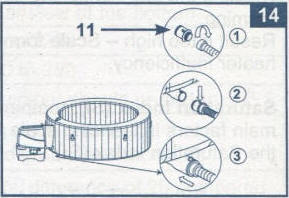

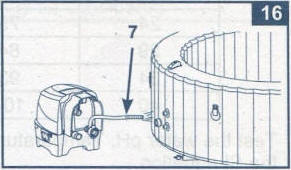
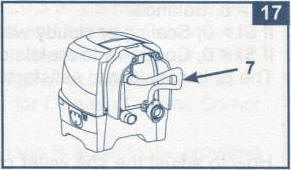
Spa Tub Cleaning
If dirt is visible in the water or water becomes cloudy and proper water chemistry does not clear it up, change the water and clean the spa tub.
See "Spa Tub Drainage" section on how to drain the spa.
While empty, remove the cartridge housing from inside of the spa tub wall, clean and/or replace the filter cartridge. Use a sponge and mild soap solution to wipe away any soil or stains on the inside of the spa wall. Rinse thoroughly before refilling with clean water.
IMPORTANT: Do not use steel wool, hard brushes or abrasive cleaners. Biofilm Removal
See your local spa professional for biofilm removal products and advice. Spa Tub Air Valve Fastening
Check the spa tub air valve for leakage and tightness before use. If air is leaking from the air valve, use the provided wrench (22) to tighten the air valve as follow:
1. Make sure the spa tub is deflated, open the air valve cap and insert the wrench (22) into the air valve body (see drawing 18).
2. With one hand, hold the backside of the air valve base from the inside of the spa tub wall and turn the wrench (22) clockwise.
IMPORTANT: Never adjust the air valve base when the spa is in use or filled with water. Only use the air valve wrench if the air valve is loose or there is leakage around air valve base. Do not over tighten the air valve: over tightening can damage the valve. Just ensure the air valve is snug and not leaking. 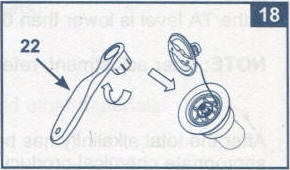
Spa Cover
Inspect the spa cover regularly for leaks, premature wear and tear, damage, or signs of deterioration. Never use a worn or damaged cover: it will not provide the level of protection required to prevent unsupervised access to the spa by a child.
Clean the cover inside and outside periodically using a sponge and a suitable solution that includes adequate disinfection (10 mg per liter of free chlorine). Do not use steel wool, hard brushes or abrasive cleaners. Spa Surround
Barefoot areas and relaxing areas around the spa shall be cleaned on a regular basis. No cleaning water may flow into the spa or spa water cycle. The dirt and cleaning agents shall be rinsed carefully to drain in the spa surround. Spa Tub and Cover Air Bladder Repair
Use the enclosed repair patch to repair any puncture:
• Clean and dry the area to be repaired thoroughly.
• Remove the patch backing paper and press patch firmly over the puncture. Smooth out the surface to remove any air bubbles under the patch.  ● ● 
|